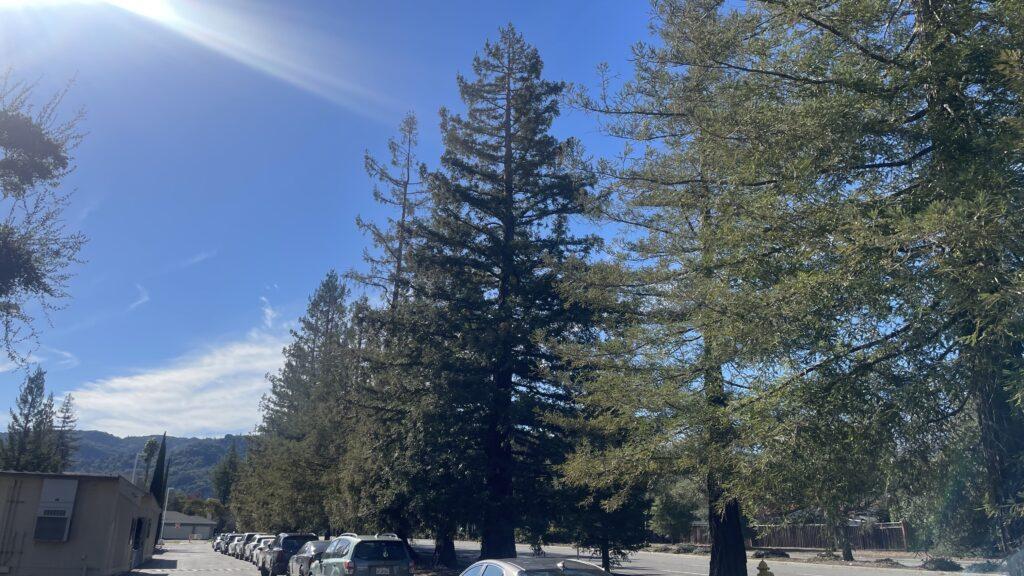Located by the foothills of the Santa Cruz Mountains, the school’s campus spans 40 acres — built atop a former prune yard when the school was established in 1959.
In the early 1950s, Saratoga had little urban or even suburban development and under 1,500 residents. Farms and orchards were common sights. Then post-World War II construction of single-family homes began at warp speed, turning the town into a desired community for young families. By the time the school opened its doors to freshmen and sophomores a decade later, the building boom had resulted in significantly more housing and a population of roughly 14,000 residents.
The city’s flat landscape nestled between hills is still synonymous with its topography today; since the school’s beginning, the city’s population has increased to more than 30,000.
Despite the farmland’s conversion to suburban lots for housing, multiple species of trees continue to flourish on campus. From the Quaking Aspens growing by the quad steps to the oak trees lining the English wing, the school’s trees are watered and trimmed by maintenance supervisor Paul Weir and two landscapers: Richard Fernandes, who maintains the exterior of the campus (including parking lots and sports venues), and Luis Sanchez, who maintains the interior of the campus.
Redwood, Cypresses, Hollywood Juniper and Pepper are the most prevalent types of trees on campus. According to assistant principal Matt Torrens, a diverse variety of tree species, such as palm trees and Japanese Maples, were chosen to reflect the different cultures of the student body.
Many of these trees have been growing for decades, the oldest of which is a Redwood growing between the football field and the sports court, inherited from the farm that the school was built on. Other Redwood and Cottonwood trees, planted in the quad when the school was established, have now grown up to be over 100 feet tall.
However, many of these trees are getting near the end of their lifespans, leading Weir to create a landscape plan to substitute new trees for some existing trees.
As the maintenance crew prioritizes safety, Weir recently invited Bartlett Tree Experts to tour the campus and map trees that may need to be replaced. For instance, three Hollywood Junipers — each around 30 feet tall — around the Journalism Room are major hazards, as the species is a fire accelerator.
Additionally, many trees in the school corridors only have trunks visible, with the majority of the canopy above the roof. This creates extra work for the maintenance crew when trees drop leaves and acorns, and the crew also prefers to have smaller, less mature flora on campus that are actually visible, rather than just trunks, Weir said.
“Maintaining the campus is a big job,” Weir said. “Some trees have just outgrown their life here. Others are dangerous and are in need of a trim because they’re just so big.”
When trees have one yellow ribbon similar to caution tape tied around them, it represents that the maintenance crew will be working with an arborist or tree-cutting company over the weekends to trim the tree. If there are two ribbons, it means the tree will be cut down.
The number of ribbons placed on trees has increased significantly lately with the recent winter storms, making the maintenance crew’s job more difficult. Following the storms, the maintenance crew removed 20 yards of debris from the campus walkways and also routinely monitored the storm drains to ensure that they didn’t back up, leading to mini floods in the hallways.
“When you see all the limbs on the ground, bushes torn up, debris everywhere — we clean that up,” Weir said. “The winds snap off weaker branches and leaves, so it becomes a job to pick up everything that breaks off.”
Through the maintenance team’s continual work with landscaping and tree upkeep, Weir has noticed a gradual improvement in the campus’s visual appeal.
“When I first saw Saratoga High [in 1975], it looked like a prison,” said Weir, a longtime resident of the area who graduated from the school. “To me, it was the cinderblock tiles that were all squared up in front and all one level. But over the years, I’ve seen it soften and the landscape mature.”


























